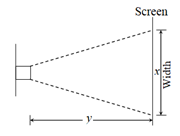
a.
the maximum image width that can be projected.
a.
Answer to Problem 29PPE
y = 1. 8x
Explanation of Solution
Given Information
A projector and a screen, of which the distance between is ’12 feet’ and the width of the image described as a condition that for obtaining the required distance we have to multiply the image width by 1.8.
Calculation

Let, the distance of projector to the screen be ‘ y’ and, the desired width of image be ‘ x’ .
Now, we will establish a relation between distance and width of image as a function of width.
Since, the manual clearly states that for requiring distance, we have to multiply the desired width by 1.8
So,
b.
that can the projector able to project the image
b.
Answer to Problem 29PPE
not possible
Explanation of Solution
Given Information
A projector and a screen, of which the distance between is ’12 feet’ and the width of the image described as a condition that for obtaining the required distance we have to multiply the image width by 1.8.
Calculation:
For an image of 7 feet, we have to put the value of x = 7 feet in our established equation,
⇒
So, the distance comes out to be 12.6 feet.
But the maximum Length of hall is 12 feet.
Conclusion
So, it is not possible to project an image of 7 feet.
c.
that can the projector able to project the image
c.
Answer to Problem 29PPE
6.6 feet
Explanation of Solution
Given Information
A projector and a screen, of which the distance between is ’12 feet’ and the width of the image described as a condition that for obtaining the required distance we have to multiply the image width by 1.8.
Calculation:
The maximum image width, which can be projected in room, shall be calculated as
⇒
We are given,
So,
Conclusion So, the maximum image width that can be obtained is 6.6 feet.
Chapter 4 Solutions
High School Math 2015 Common Core Algebra 1 Student Edition Grade 8/9
Additional Math Textbook Solutions
Intro Stats, Books a la Carte Edition (5th Edition)
Algebra and Trigonometry (6th Edition)
Elementary Statistics
Basic Business Statistics, Student Value Edition
College Algebra (7th Edition)
Calculus: Early Transcendentals (2nd Edition)
- 3. Graph the function f(x) = −(x-2)²+4 Answer: f(x) 6 5 4 3 2+ 1 -6-5 -4-3-2-1 × 1 2 3 4 5 6 -1 -2+ ရာ -3+ -4+ -5 -6arrow_forward2. Graph the function f(x) = cos(2x)+1 Answer: -2π 一元 y 3 2- 1 -1 -2+ ရာ -3- Π 2πarrow_forward2. Graph the function f(x) = |x+1+2 Answer: -6-5-4-3-2-1 f(x) 6 5 4 3 2 1 1 2 3 4 5 6 -1 -2 -3 -4 -5 -6arrow_forward
- 1. The table shows values of a function f(x). What is the average rate of change of f(x) over the interval from x = 5 to x = 9? Show your work. X 4 f(x) LO 5 6 7 8 9 10 -2 8 10 11 14 18arrow_forward• Find a real-world situation that can be represented by a sinusoidal function. You may find something online that represents a sinusoidal graph or you can create a sinusoidal graph yourself with a measuring tape and a rope. • Provide a graph complete with labels and units for the x- and y-axes. • Describe the amplitude, period, and vertical shift in terms of the real-world situation.arrow_forwardf(x) = 4x²+6x 2. Given g(x) = 2x² +13x+15 and find 41 (4)(x) Show your work.arrow_forward
- f(x) = x² − 6x + 8 3. Given and g(x) = x -2 solve f(x) = g(x) using a table of values. Show your work.arrow_forward1. Graph the function f(x) = 3√x-2 Answer: -6-5 -4-3-2 -1 6 LO 5 f(x) 4 3 2+ 1 1 2 3 4 5 6 -1 -2+ -3 -4 -5 -6- 56arrow_forwardA minivan is purchased for $29,248. The value of the vehicle depreciates over time. • Describe the advantages and disadvantages of using a linear function to represent the depreciation of the car over time. • Describe the advantages and disadvantages of using an exponential function to represent the depreciation of the car over time. • The minivan depreciates $3,000 in the first year. Write either a linear or exponential function to represent the value of the car x years after it was sold.arrow_forward
- Nasir invested $415 into a savings account that earns 2.5% annual interest. Tiana invested $295 into a saving account that earns 6.8% annual interest. Who will have more money after 7 years? How much more money will the person have?arrow_forwardNasir invested $415 into a savings account that earns 2.5% annual interest. Tiana invested $295 into a saving account that earns 6.8% annual interest. Who will have more money after 7 years? How much more money will the person have?arrow_forwardSolve for the variable. 62k = 7776k- 8arrow_forward
 Algebra and Trigonometry (6th Edition)AlgebraISBN:9780134463216Author:Robert F. BlitzerPublisher:PEARSON
Algebra and Trigonometry (6th Edition)AlgebraISBN:9780134463216Author:Robert F. BlitzerPublisher:PEARSON Contemporary Abstract AlgebraAlgebraISBN:9781305657960Author:Joseph GallianPublisher:Cengage Learning
Contemporary Abstract AlgebraAlgebraISBN:9781305657960Author:Joseph GallianPublisher:Cengage Learning Linear Algebra: A Modern IntroductionAlgebraISBN:9781285463247Author:David PoolePublisher:Cengage Learning
Linear Algebra: A Modern IntroductionAlgebraISBN:9781285463247Author:David PoolePublisher:Cengage Learning Algebra And Trigonometry (11th Edition)AlgebraISBN:9780135163078Author:Michael SullivanPublisher:PEARSON
Algebra And Trigonometry (11th Edition)AlgebraISBN:9780135163078Author:Michael SullivanPublisher:PEARSON Introduction to Linear Algebra, Fifth EditionAlgebraISBN:9780980232776Author:Gilbert StrangPublisher:Wellesley-Cambridge Press
Introduction to Linear Algebra, Fifth EditionAlgebraISBN:9780980232776Author:Gilbert StrangPublisher:Wellesley-Cambridge Press College Algebra (Collegiate Math)AlgebraISBN:9780077836344Author:Julie Miller, Donna GerkenPublisher:McGraw-Hill Education
College Algebra (Collegiate Math)AlgebraISBN:9780077836344Author:Julie Miller, Donna GerkenPublisher:McGraw-Hill Education





